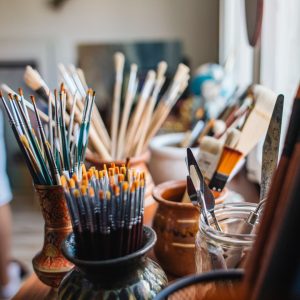
Harnessing Healing Hooves: Exploring Equine-Assisted Therapy
October 13, 2023
Shattered Ceilings and Unbalanced Homes: Why do women get asked “How do you juggle it all?”
December 4, 2023By Gianna Damis, ATR-BC, LPC
2 min read

Have you ever shown up to your eating disorder therapy session, only to realize you’re unsure what to talk about?
Maybe you know you have been having a difficult time but just aren’t sure how to express it. On the other hand, you might know how to talk about your experience but are feeling burnt out as you revisit the same topics repeatedly.
Art Therapy for Eating Disorders
When we develop an eating disorder, it’s very easy to lose our sense of self in the process. Art therapy helps to bridge that gap by getting you back in touch with yourself and your emotions. It engages you in an art task that aligns with your therapeutic goals. Nonverbal, symbolic communication (like through art) has been shown to:
- Support self-awareness
- Personal expression
- Self-esteem
- Adopting new perspectives
- Alleviating pain
Maybe you could use some support in finding your motivation for recovery and processing life’s stresses that contribute to your eating disorder. You may be looking to get more in touch with your emotions and body, or you’re itching for a supportive, holistic way to express yourself. Art therapy is a tool to help with all of that and more. No matter where you are in your recovery journey, you may be able to benefit from art therapy.
What is Art Therapy?
The art therapist generally provides a task that aligns with your therapeutic goals and then facilitates the processing of your artwork by asking focused questions. They will typically have a variety of materials for you to work with in 2D and possibly 3D, but you can also do art therapy while in a telehealth session!
Contrary to common myths, you do not need prior art experience to engage in art therapy. Art therapists commonly approach sessions in a way where they are not psychoanalyzing what you make. Instead, they want to hear what you have to say about your artwork and the meaning you make of it. Your journey in art therapy is your journey, and the art therapist’s role is to help facilitate that.
Find Art Therapy Near Me
While art making can be beneficial even if we do engage in it on our own, art therapy can only be done in the presence of a trained art therapist. Through this process, you might be surprised to learn new things about your inner world or feel relieved after expressing a part of yourself in a safe space.
You can work with an art therapist by contacting Evolve Counseling Services or visiting the American Art Therapy Association website and clicking “Art Therapist Locator” under “Resources.” Click here for access!
_________________________________________________________________________________
Looking for treatment for an eating disorder, anxiety, depression, trauma, or postpartum mood disorder?
Evolve Counseling Services is a specialized team of Licensed Therapists providing treatment in Paoli.


